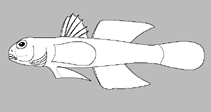Anatirostrum profundorum (Berg, 1927)
Duckbill pugolovka
Upload your photos and videos
Google imageNo image available for this species;
drawing shows typical species in Gobiidae.
Google imageNo image available for this species;
drawing shows typical species in Gobiidae.
Classification / Names Common names | Synonyms | Catalog of Fishes(genus, species) | ITIS | CoL | WoRMS | Cloffa
Teleostei (teleosts) > Gobiiformes (Gobies) > Gobiidae (Gobies) > Gobiinae
Etymology: Anatirostrum: Latin, anas = duck + Latin, rostrum = face (Ref. 45335).
More on author: Berg.
Etymology: Anatirostrum: Latin, anas = duck + Latin, rostrum = face (Ref. 45335).
More on author: Berg.
Environment: milieu / climate zone / depth range / distribution range Ecology
Freshwater; bathydemersal; depth range ? - 294 m (Ref. 2058). Temperate
Distribution Countries | FAO areas | Ecosystems | Occurrences | Point map | Introductions | Faunafri
Former USSR and Asia: Endemic to the southern part of the Caspian Sea.
Size / Weight / Age
Short description Identification keys | Morphology | Morphometrics
Dorsal spines (total): 4; Dorsal soft rays (total): 9 - 11; Anal spines: 1; Anal soft rays: 11; Vertebrae: 29. Distinguished by the following characters: body and head elongate, narrow; leathery barbel on chin, uniform light gray with dark gray speckles (Ref. 33724); fins: D1IV, D2 I/10, A I/11, P 14-16 (14:1, 15:2,16:1), V I/5+5/I, C 13 (branched rays) (1,13,1: 2; 2,13,1: 1; 1,13,2: 1), procurrent spines dorsal 2-4 (2:1,3:1,4:2) and ventral 2-3 (2: 1,3:3); scales absent; tiny platelets and granules, knob-like with few posteriad directed spines arranged as one or several irregular transverse rows or as patch, smallest on dorsal side of the head, larger on opercle and preopercle; premaxilla and dentary with caninoid teeth in 4-5 rows medially; outer row bears largest teeth;
no large canines developed (Ref. 36191).
Caught with a Sigsbee trawl at a depth of 294 m over white silt, on 22 April 1904 by the expedition of N.M. Knipovich (Ref. 2058).
Life cycle and mating behavior Maturity | Reproduction | Spawning | Eggs | Fecundity | Larvae
Main reference
Upload your references | References | Coordinator | Collaborators
Coad, B.W., 1998. Systematic biodiversity in the freshwater fishes of Iran. Ital. J. Zool. 65:101-108. (Ref. 31728)
IUCN Red List Status (Ref. 130435: Version 2024-2)
Least Concern (LC) ; Date assessed: 04 March 2020
CITES
Not Evaluated
Threat to humans
Harmless
Human uses
FAO - Publication: search | FishSource |
More information
Trophic ecology
Food items
Diet composition
Food consumption
Food rations
Predators
Food items
Diet composition
Food consumption
Food rations
Predators
Ecology
Ecology
Ecology
Population dynamics
Growth parameters
Max. ages / sizes
Length-weight rel.
Length-length rel.
Length-frequencies
Mass conversion
Recruitment
Abundance
Growth parameters
Max. ages / sizes
Length-weight rel.
Length-length rel.
Length-frequencies
Mass conversion
Recruitment
Abundance
Life cycle
Reproduction
Maturity
Maturity/Gills rel.
Fecundity
Spawning
Spawning aggregations
Eggs
Egg development
Larvae
Larval dynamics
Reproduction
Maturity
Maturity/Gills rel.
Fecundity
Spawning
Spawning aggregations
Eggs
Egg development
Larvae
Larval dynamics
Anatomy
Gill area
Brain
Otolith
Gill area
Brain
Otolith
Physiology
Body composition
Nutrients
Oxygen consumption
Swimming type
Swimming speed
Visual pigments
Fish sound
Diseases & Parasites
Toxicity (LC50s)
Body composition
Nutrients
Oxygen consumption
Swimming type
Swimming speed
Visual pigments
Fish sound
Diseases & Parasites
Toxicity (LC50s)
Genetics
Genetics
Heterozygosity
Heritability
Genetics
Heterozygosity
Heritability
Human related
Aquaculture systems
Aquaculture profiles
Strains
Ciguatera cases
Stamps, coins, misc.
Aquaculture systems
Aquaculture profiles
Strains
Ciguatera cases
Stamps, coins, misc.
Tools
E-book | Field guide | Length-frequency wizard | Life-history tool | Point map | Classification Tree
| Catch-MSY |
Special reports
Download XML
Internet sources
AFORO (otoliths) | Aquatic Commons | BHL | Cloffa | BOLDSystems | Websites from users | Check FishWatcher | CISTI | Catalog of Fishes: genus, species | DiscoverLife | ECOTOX | FAO - Publication: search | Faunafri | Fishipedia | Fishtrace | GenBank: genome, nucleotide | GloBI | Google Books | Google Scholar | Google | IGFA World Record | MitoFish | Otolith Atlas of Taiwan Fishes | PubMed | Reef Life Survey | Socotra Atlas | Tree of Life | Wikipedia: Go, Search | World Records Freshwater Fishing | Zoological Record
Estimates based on models
Phylogenetic diversity index (Ref. 82804): PD50 = 1.0000 [Uniqueness, from 0.5 = low to 2.0 = high].
Bayesian length-weight: a=0.00955 (0.00355 - 0.02566), b=3.03 (2.80 - 3.26), in cm total length, based on LWR estimates for this (Sub)family-body shape (Ref. 93245).
Trophic level (Ref. 69278): 3.1 ±0.3 se; based on size and trophs of closest relatives
Resilience (Ref. 120179): High, minimum population doubling time less than 15 months (Preliminary K or Fecundity.).
Fishing Vulnerability (Ref. 59153): Low vulnerability (10 of 100).




